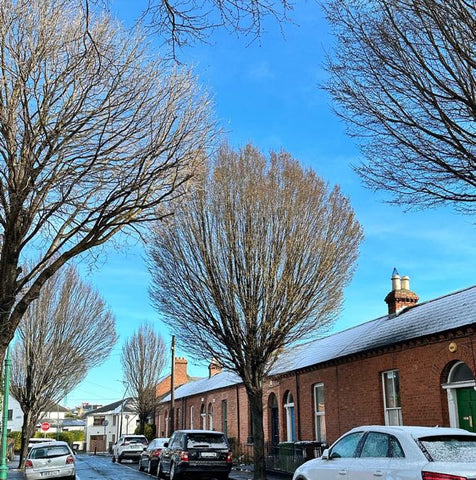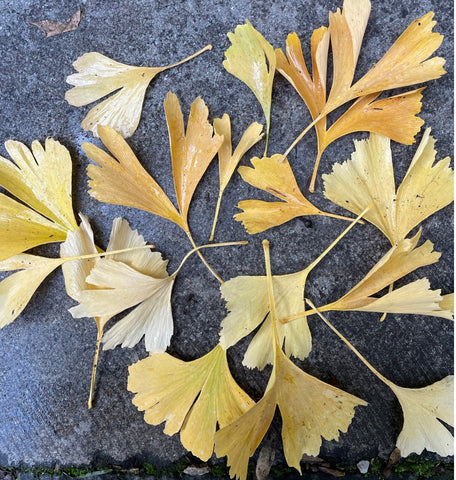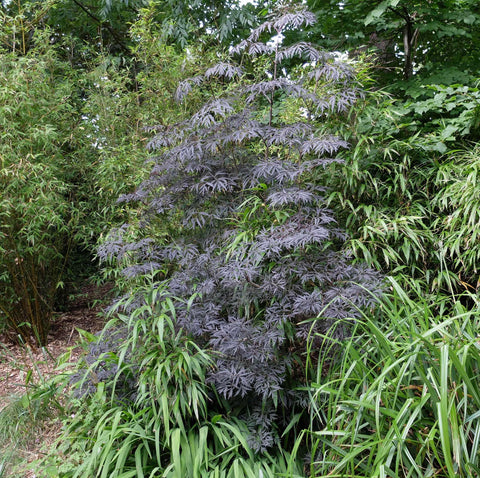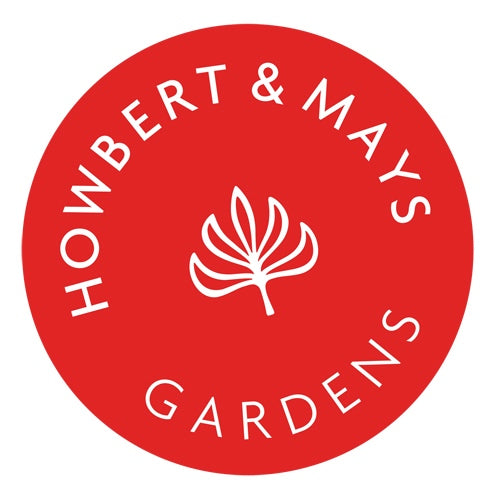Acacia / Mimosa / Wattle
There are a few different varieties of this fast-growing evergreen tree that grow well in and around Dublin.

Acacia dealbata is the most common, with small fluffy leaves and yellow pom-pom flowers in winter and spring. It can get a little unruly, so you need a bit of space for this. Our advice is to chop it down by half about a year after planting, which will encourage it to be a denser, bushier plant. For a sunny, well-drained area. Good if you want effective screening and you have plenty of space.
Acacia longifolia has a similar shape and growing speed and flower, but more conventional, almost willow-like flower.
Acacia baileyana 'Purpurea' is a more fragile acacia, suitable for smaller spaces, but requiring full sun and shelter from strong or drying winds. The new growth is wonderfully purple, and there are also sweet fluffy yellow flowers. However, they can look messy if they are in an exposed of windy spot. For milder areas only.
- - - - - - - - - - - - - - - - - - - - - - - - - - - - - - - - - - - - - - - - - - - - - - - - - - - - - -
Acer / Maple
There are dozens of lovely maples that thrive in Irish gardens. Most have fabulous leaf colour, especially in autumn. Preferably out of strong wind, they can cope with sun or shade. Ideal in small to medium sized gardens, or even in enclosed inner courtyards. They lose their leaves in the winter, but the fabulous autumn and spring colour makes it worthwhile.
Acer palmatum / Japanese maple: some of our favourite cultivars include 'Aconitifolium', 'Bloodgood', 'Dissectum', 'Katsura' and 'Osakazuki'. they can even thrive in a large pot. Try to not cut back a Japanese maple or trim the branches mid way. If they are too big or get in your way, always remove a branch at its base or get a trained, knowledgeable gardener to do it for you.
Acer davidii or Acer Pannsylvanicam / Snakenark maple: a choice maple with wonderful bark patterned like a snake. Taller and more upright that Japanese maple, and perfect for a lightly-shaded, sheltered garden. It also have excellent autumn colour.
Acer griseum / Paperbark maple: you see these occasionally in Dublin gardens. They can grow to a similar size as a birch, perhaps a little more rounded. Not for the tiny garden, but excellent in a front garden where you may park a couple of cars and have room for a medium-sized tree. Fantastic shaggy bark, excellent autumn leaf colour and a fine specimen all year round.

Acer palmatum dissectum, DunLaoghaire, Co Dublin

Acer palmatum, Foxrock, Co Dublin
- - - - - - - - - - - - - - - - - - - - - - - - - - - - - - - - - - - - - - - - - - - - - - - - - - - - - -
Amelanchier / Snowy mespilus / Serviceberry
This small to medium-sized deciduous tree is a good choice for the suburban or urban garden. White flowers in late spring / early summer are followed by small berries in autumn, popular with birds (and edible by humans too). New leaves often appear with reddish tips, and most Amelanchiers also have good autumn colour. The variety 'Ballerina' is particularly elegant, with profuse white flowers. The variery 'Obelisk' is an upright-growing form, with the same white flowers, autumn colour and red berries, but a vertical habit, making it especially useful for a garden where space is tight.

- - - - - - - - - - - - - - - - - - - - - - - - - - - - - - - - - - - - - - - - - - - - - - - - - - - - - -
Araucaria araucana / Monkey puzzle

Araucaria araucana / Monkey puzzle, North Circular Doad, Dublin
- - - - - - - - - - - - - - - - - - - - - - - - - - - - - - - - - - - - - - - - - - - - - - - - - - - - - -
Arbutus / Strawberry tree
An unusual evergreen tree that is native to Ireland as well as south-western Europe. The variety that grows wild in the south west of Ireland is Arbutus unedo, or Caithne in Irish. A medium to large tree, it has lovely dark red bark, somewhat flaky, serrated glossy leaves, heather-like white flowers and cherry-sized red fruit that is edible, though not very tasty. It is sometimes planted in gardens around Dublin, and when mature it can be quite imposing. It's a truly special tree, and if you have the space you should consider it. They can be spotted around Bray in particular, but here and there in the suburbs, especially the milder parts near the sea. The cultivar 'Compacta' will stay much smaller at around 2.5 cmin height by a similar width. The cultivar 'Rubra' has pink to red flowers and an ultimate height and spread of 4-8 metres. Arbutus require acidic soil, which many areas have anyway, but if you are unsure, you should do a soil pH test. Flowers are beloved by bees and other insects.

Arbutus unedo behind Newman House, Stepen's Green, Dublin 2

Arbutus x andrachnoides in Dublin 4. Formerly part of Trinity's botanical gardens.

Arbutus unedo in a front garden, Bray, Co Wicklow

Flowers and fruit of an Arbutus unedo in Bray, Co Wicklow
- - - - - - - - - - - - - - - - - - - - - - - - - - - - - - - - - - - - - - - - - - - - - - - - - - -
Azara microphylla and Azara dentata/ Box-leafed Azara
A rarely planted, elgant evergreen tree with small glossy leaves almost like a box. It's a slow-growing plant, a rare choice because it takes many years to become an actual tree. On the other hand, it is a hardy, somewhat shade tolerant plant with lovely airy foliage and a slender shape. It has tiny, almost invisible flowers with the most delicious vanilla scented flowers in spring. A perfect choice for a sheltered city garden, but you will need time for it to come into its own.

A mature Azara microphylla in a front garden in Bray, Co Wicklow.


Azara dentata, front garden, Killiney, Co Dublin
- - - - - - - - - - - - - - - - - - - - - - - - - - - - - - - - - - - - - - - - - - - - - - - - - -
Betula / Birch
Birches have to be one of the most-planted trees around Dublin. Known for their white bark, cheery green leaves, general resilience and manageable size, they really do make a good choice for many situations.

A note on birches. They almost always look dreadfull if they are 'topped'. They should not be cut like this and they never regain a graceful shape. Either let a birch grow to its natural size, or don't plant one to begin with. They can grow up to 15 metres in height and 5-10 metres in width.
Some people plant birches in small clusters, even in tight grouping so that they almost read as one tree. This will help to restrict their height and spread, and you will also have a great display of their attractive trunks. Alternatively, a multistem birch is one that has been cut down when young and then sent up multiple new stems.
Two birches are native to Ireland, Betula pendula and Betula pubescens. They have white bark (though not as white as some varieties) a little flaky, and make a good choice for a wild part of the garden or for anyone wanting to stick to a native planting pallette.
The Himalayan birch (Betula utilis var. jacquemontii) is the birch that most people request, because it has the whitest of all birch barks. When the trees are more than a few years old the white bark appears. These trees look fabulous against red brick in particular, and can be grown only a few metres away from buildings without damaging them.
Other varieties worth looking out for are Betula 'Fascination', which has a similar flaking bark to jacquemontii, but with a peachy-pink colour. Betula lenta is an unusual variety from North America whose wood and twigs have a wonderful wintergreen flavour. Betula papyrifera is the Paper-bark birch, whose white bark is especially peeling, while Betula nigra (the river birch) has a very shaggy bark that makes it a winter eye catcher.

Betula 'Fascination', Ranelagh, Dublin 6

Himalayan birch (Betula jacquemontii), Deansgrange, Co Dublin

Silver birch (Betula pendula) Deansgrange, Co Dublin
- - - - - - - - - - - - - - - - - - - - - - - - - - - - - - - - - - - - - - - - - - - - - - - -
Carpinus betulus / Hornbeam

Carpinus, Portobello, Dublin 8
-----------------------------------------------------------------------------------
Cercidiphyllum japonicum / Katsura tree
A medium-sized deciduous tree with beautiful leaves in spring, summer and autumn. In spring the rounded, medium-sized leaves are tinged with bronze. In summer they are mainly green, and in autumn they turn shades of orange, yellow and red. At this time of year they also smell of burnt sugar, candyfloss or toffee. Plant near other trees or in a sheltered location, in most soils. Can grow up to 12 metres in height, fairly upright and multo-branched. Ideal for a Japanese or Chinese themed garden.

Foliage of Cercidiphyllum in Dublin zoo.

Cercidiphyllum in Trinity College, Dublin.
- - - - - - - - - - - - - - - - - - - - - - - - - - - - - - - - - - - - - - - - - - - - - - -- -
Cercis / Judas tree
Another beautiful and unusual small to medium-sized tree with elegant branch structure and small pink flowers in early summer. Suitable for most gardens and most soils; plant in a location out of strong, damaging winds. There are many varieties of this tree, including 'Forest Pansy' with beautiful dark red foliage.

- - - - - - - - - - - - - - - - - - - - - - - - - - - - - - - - - - - - - - - - - - - - - - - - - - - - - -
Cotoneaster
Cotoneaster comes in many shapes and sizes. You sometimes you see these small, evergreen trees, festooned with red berries, in gardens around Dublin. The leaves are long and thin and the plants are tough, durable and able to withstand almost all conditions. Excellent for screening.
- - - - - - - - - - - - - - - - - - - - - - - - - - - - - - - - - - - - - - - - - - - - - - - - - - - - -
Cordyline / Palm tree
Love them or hate them, Cordylines seem to divide opinions. Native to New Zealand, they grow very well along much of the Irish coast, thriving in the exposed, salt-laden conditions near the sea. For sun or shade, windy or sheltered. The futher inland they are planted the more risk they can be damaged in severe winter, but even those hit with extremely low temperatures over the decades have bounced back again. They are evergreen, but do shed their long strappy leaves, making them a little messy as the leaves need to be regularly collected. The flowers in summer are highly perfumed, and these trees do lend a cheery, tropical atmosphere to wherever they are. On the ground, they take up almost no space. They can be excellent screening plants. They grow in almost all conditions, starting out life as grassy plants and only becoming tall and woody over several years.

Cordyline australis, Sandycove, Co Dublin

Cordyline australis, Deansgrange, Co Dublin
- - - - - - - - - - - - - - - - - - - - - - - - - - - - - - - - - - - - - - - - - - - - - - - - - - - - - -
Cornus / Dogwood
Probably the most-planted Cornus around Dublin is the 'wedding cake tree' (Cornus contraversa or Cornus contraversa 'Variegata'). The beautifully tiered branches spread out horizontally, red-twigged, with pale green leaves emerging in spring and turning red or orange in autumn. A wedding cake tree in the right position can be an incredible sight, but enough space - particularly width - is needed. You should allow for them to grow up to 6 or 7 metres in width when mature. Careful, selective pruning of vertical shoots will enhance the tiered branch structure.
There are many other varieties of Cornus that thrive around the Dublin area, and some of the smaller ones include Cornus kousa and cultivars such as 'China Girl'. Cornus capitata is a larger, evergreen species with green-white flowers followed by red, ball-shaped fruit. It's a beautiful plant but not often seen in Dublin gardens.

Cornus contraversa 'Variegata' in Monkstown, Co Dublin

Flowers of Cornus contraversa (May-June)
- - - - - - - - - - - - - - - - - - - - - - - - - - - - - - - - - - - - - - - - - - - - - - - - - - - - - -
Crataegus / Hawthorn
The native hawthorn is a beautiful sight in early summer (around May), with masses of white flowers. In autumn and winter, Hawthorns are covered in small red berries which are an important food source for birds. Hawthorns are tough plants, traditionally used in hedgerows as field boundaries because of their thorny twigs and relilience in difficult conditions. In Irish culture, the hawthorn is known as a 'fairy tree', and often a single speciman is regarded as a sacred or special tree. As a native plant, it plays an important part in local ecology. Consider planting a hawthorn hedge, which can be kept tighly clipped, or grow one as a stand-alone specimen. Suitable for a small to medium-sized garden or as part of a garden boundary with other prickly plants such as Holly.
There are many other varieties of Hawthorn, grown more as specimen trees. The most well-known is Crataegus 'Paul's Scarlet', quite similar to the native hawthorn but with dark pink flowers.

Crataegus on Killiney Hill, Co Dublin

Crataeugus in a front garden, Co Dublin

Crataegus monogyna, Waslkinstown, Co Dublin
- - - - - - - - - - - - - - - - - - - - - - - - - - - - - - - - - - - - - - - - - - - - - - - - - - - - - -
Eucalyptus / Gum tree
Eucalyptus are fast-growing evergreen trees, most suited for a larger gardens. You do see them around most Dublin suburbs, and in particular around seaside locations such as Killiney, where gardens are larger and they have room to grow to their full size. For smaller gardens, they can be cut back to a more manageable size, or even trimmed regularly so that they are bushy rather than tree-shaped. The young leaves are rounded and the mature leaves are longer and thinner. The foliage and seeds are very fragrant, and the bark on mature specimens is flaky and mottled in various shades. Because of their large size, best planted not too close to a house.
The most commonly planted Eucalyptus around Dublin is Eucalyptus gunnii, but there are other species and varieties that are often chosen for their leaf shape, and are predominantly grown for their use in floristry.

- - - - - - - - - - - - - - - - - - - - - - - - - - - - - - - - - - - - - - - - - - - - - - - - - - - - - -
Eucryphia
Fast-growing, upright, evergreen small tree with large white flowers in summer or autumn. Flowers are beautiful and also attractive to bees. Eucryphias prefer moister soil and a low pH, so they are not for everywhere. On the other hand, they do grow well in many gardensa round Dublin, so their requirements shouldn't put you off. We frequently stock Eucryphia x nymansensis or Eucryphia glutinosa, as well as other varieties. As columnar, evergreen trees they are useful in medium-sized gardens, especially where screening is required. However, they are not a plant that lend themselves to being tightly clipped.
- - - - - - - - - - - - - - - - - - - - - - - - - - - - - - - - - - - - - - - - - - - - - - - - - - - - - -
Fagus / Beech

Beech hedge, Monkstown, Co Dublin

Copper beech, Deansgrange, Co Dublin
- - - - - - - - - - - - - - - - - - - - - - - - - - - - - - - - - - - - - - - - - - - - - - - - - - - - - -
Ginkgo


- - - - - - - - - - - - - - - - - - - - - - - - - - - - - - - - - - - - - - - - - - - - - - - - - - - - - -
Gleditsia

Gleditsia, Dun Laoghaire
- - - - - - - - - - - - - - - - - - - - - - - - - - - - - - - - - - - - - - - - - - - - - - - - - - - - - -
Hoheria
- - - - - - - - - - - - - - - - - - - - - - - - - - - - - - - - - - - - - - - - - - - - - - - - - - - - - -
Ilex / Holly

- - - - - - - - - - - - - - - - - - - - - - - - - - - - - - - - - - - - - - - - - - - - - - - - - - - - - -
Laurus / Bay laurel
- - - - - - - - - - - - - - - - - - - - - - - - - - - - - - - - - - - - - - - - - - - - - - - - - - - - -
Liquidambar
- - - - - - - - - - - - - - - - - - - - - - - - - - - - - - - - - - - - - - - - - - - - - - - - - - - - - -
Magnolia

Magnolia grandiflora, Churchtown

Magnolia campbellii, North Circular Road

Magnolia soulangeana, Terenure
- - - - - - - - - - - - - - - - - - - - - - - - - - - - - - - - - - - - - - - - - - - - - - - - - - - - - -
Malus
- - - - - - - - - - - - - - - - - - - - - - - - - - - - - - - - - - - - - - - - - - - - - - - -
Maytenus

Maytenus in Ranelagh, Dublin 6

Maytenus in Drumcondra, Dublin
-----------------------------------------------------------------------------------
Myrtus / Luma / Myrtle


Chilean myrtle / Luma apiculata, Glenageary
-----------------------------------------------------------------------------------
- Phoenix
- Pinus
- Pittosporum
------------------------------------------------------------------------------------
Platanus / Plane

Plane trees (Platanus) on Adelaide Road, Dublin 2

Bark of Platanus, Stephen's Green, Dublin

Plane tree (Platanus), planted by Howbert & Mays, Fitzwilliam Square, Dublin.
- - - - - - - - - - - - - - - - - - - - - - - - - - - - - - - - - - - - - - - - - - - - - - - - - - - - - -
- Prunus
- Pyrus
- Quercus
- Rhus
- Robinia
- - - - - - - - - - - - - - - - - - - - - - - - - - - - - - - - - - - - - - - - - - - - - - - - - - - - - -
Sambucus / Elder
A pretty native shrub or small tree. Great for wildlife and able to grow almost anywhere. Perfect for a wildlife garden. Plant with hollies, hawthorn and birches for a nature-friendly woodland corner. Elder grows fast and can be either a small tree or a many-stemmed shrub. Stems can be trimmed to ground level to keep it at a manageable size, or allow to grow into a small, single-stemmed tree. Pretty creamy white flowers in late spring and dark almost black berries in autumn, which are popular with birds. The variety 'Black Lace' has cut-leaf dark foliage, and the flowers are pale pink. A beautiful ornamental shrub or small tree.

- - - - - - - - - - - - - - - - - - - - - - - - - - - - - - - - - - - - - - - - - - - - - - - - - - - - - -
- Sophora

Sophora japonica, Killiney, Co Dublin
- Sorbus
- Syringa
- Tetradium
- Tilia

